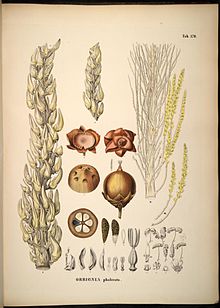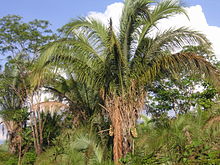Attalea
| Attalea | ||||||||||||
|---|---|---|---|---|---|---|---|---|---|---|---|---|

|
||||||||||||
| Systematics | ||||||||||||
|
||||||||||||
| Scientific name | ||||||||||||
| Attalea | ||||||||||||
| Kunth |
Attalea is a genus of palm that is native to Central and South America. The species are used in a variety of ways, including for oil extraction ( babassu oil ).
features
The representatives are small to large, single-stemmed palms, the trunk of which remains underground or is upright. They are unarmed and monocial . The trunk is usually smooth, the leaf scars are crooked.
The chromosome number is 2n = 32.
leaves
The leaves are large, pinnate and dry up on the palm. The leaf sheath is thick, fine or coarsely fibred. The petiole is missing or short to long. It is grooved on the top (adaxial) and rounded on the bottom (abaxial). The rachis is furrowed adaxially in the lower area, angular further above, rounded or flattened abaxially. The stalk and rachis are hairy to varying degrees depending on the species. The numerous leaflets are linear-lanceolate, simply folded. They stand at regular intervals or in groups of two to five. They are irregularly lobed at the top. The midrib is clear, the other longitudinal veins rather inconspicuous. The numerous transverse veins are striking.
Inflorescences

Only one inflorescence is formed at a time; it is more upright between the leaves or becomes pendulous over time. The inflorescence is either purely male, purely female or occupied with flowers of both sexes. The inflorescence is simply branched, or the branches are short and the flowers are seemingly sessile on the main axis. The peduncle is short to long. The cover sheet remains hidden in the leaf sheath of the carrier sheet. The bract on the peduncle (“spathe”) completely envelops the inflorescence in the bud stage and has a short to long, firm beak. It rips open abaxially, becomes larger, thick and woody. Abaxially it is deeply furrowed and densely hairy, adaxially glabrous. It lasts a long time. The remaining bracts are small, triangular and leathery. On the inflorescence axis are the side axes spirally or unilaterally, each carried by a small bract.
blossoms
The male flowers are asymmetrical. The three sepals are not fused, triangular and very small. The three petals are not fused and much longer than the sepals. They are either oval-triangular, pointed and valvate or with a round cross-section and hardly valvate or basal with a round cross-section and forming a widened, triangular wing in the upper area. There are three to 75 stamens available, which are usually much shorter than the crown, rarely longer. The stamens are slender and short to long. The anthers are rather straight, but can also be twisted or twisted. They are dorsifix , more rarely medifix, the anthers are arranged intrors or latrors. The pollen grains are ellipsoidal and mostly slightly to clearly asymmetrical, sometimes they are also pear-shaped or trichotomosulcat. The germ opening of the pollen is a distal sulcus or a trichotomosulcus. The longest axis measures 32 to 85 microns.
The female flowers are much larger than the male and usually ovoid. The three sepals are not fused, rather triangular, broadly imbricated and leathery. The three petals are not fused, rounded or triangular, glabrous or hairy. There is a large, leathery, hairy staminode ring. The pistil consists of three or more fused carpels . He is ovoid to inverted pear-shaped, the stylus narrows gradually, the number of stigma lobes corresponds to the number of carpels. They are bent back during the flowering period. There is a basal ovule per carpel .
fruit

The fruits are egg-shaped, sometimes asymmetrical, and contain one or more seeds. They have a short to medium-sized beak and the remnants of the scars are at the tip of the fruit. The perianth and staminodial ring are also preserved and enlarged. The exocarp is finely furrowed and has scales. The mesocarp is usually fleshy and fibrous. The endocarp is very thick and stony. The seed is ellipsoidal or laterally flattened. It is attached at the base with finely branched raphas. The endosperm is homogeneous and firm. The embryo is basal.
Distribution and locations
The genus occurs from Mexico south to Bolivia, Peru and Brazil. The species inhabit a wide range of locations from the tropical rainforest to the dry "campo rupestre" and Cerrado .
Systematics
The genus Attalea is placed within the palm family in the subfamily Arecoideae , Tribus Cocoseae and Subtribus Attaleinae. Closely related genera within this subtribe are Lytocaryum and Syagrus . The genus is monophyletic .
There are different views on the taxonomy of Attalea , both on the number of genera and the number of species it contains. Glassman divided the species into the four genera Attalea , Scheelea , Orbignya and Maximiliana . These four genera were also recognized in 1987 in the first edition of the Genera Palmarum . However, better knowledge and new research material showed that the characteristics of the male flowers for separation into four genera are not reliable. In 1995 Henderson and colleagues transferred all species to the genus Attalea . The editors of the second edition of Genera Palmarum 2008 followed this view . The number of recognized species varies between 29 at Glassman in 1999 and 66 at Henderson in 1995.
Govaerts and Dransfield accept the following types:
- Attalea allenii H.E. Moore : Panama and northwestern Colombia.
- Attalea amygdalina Kunth : Colombia.
- Attalea amylacea (Barb.Rodr.) Zona : Brazil.
- Attalea anisitsiana (Barb.Rodr.) Zone : Brazil and Paraguay.
- Attalea apoda Burret : Brazil.
- Attalea attaleoides (Barb.Rodr.) Wess.Boer : Guiana, French Guiana, Suriname and northern Brazil.
- Attalea barreirensis Glassman : Brazil.
- Attalea bassleriana (Burret) Zona : Northern Peru.
- Attalea brasiliensis Glassman : Brazil.
- Attalea brejinhoensis (Glassman) Zona : Brazil.
- Attalea burretiana Bondar : Eastern Brazil.
- Attalea butyracea (Mutis ex Lf) Wess.Boer : Tropical South America.
- Attalea camopiensis (Glassman) Zona : French Guiana.
- Attalea cephalotus Poepp. ex Mart. : Northern Peru.
- Attalea cohune Mart. : Mexico to Nicaragua and Colombia.
- Attalea colenda (OFCook) Balslev & AJHend. : Southwest Colombia and western Ecuador.
- Attalea compta Mart. : Brazil.
- Attalea crassispatha (Mart.) Burret : Southwest Haiti.
- Attalea cuatrecasana (Dugand) AJHend., Galeano & R.Bernal : Western Columbia.
- Attalea dahlgreniana (Bondar) Wess.Boer : Suriname to Brazil.
- Attalea degranvillei (Glassman) Zona : French Guiana.
- Attalea dubia (Mart.) Burret : Southeastern and southern Brazil.
- Attalea eichleri (Drude) AJHend. : Brazil and Bolivia.
- Attalea exigua Drude : Brazil.
- Attalea fairchildensis (Glassman) Zona : Colombia.
- Attalea funifera Mart. : Brazil.
- Attalea geraensis Barb . Rodr . : Brazil and Eastern Paraguay.
- Attalea guacuyule (Liebm. Ex Mart.) Zona : Southwestern Mexico.
- Attalea guianensis (Glassman) Zona : French Guiana.
- Attalea hoehnei Burret : Brazil.
- Attalea huebneri (Burret) Zona : Northern Brazil.
- Attalea humilis Mart. ex explos. : Eastern Brazil.
- Attalea iguadummat de Nevers : Eastern Panama and northwestern Colombia.
- Attalea insignis (Mart.) Drude : Colombia, Ecuador, northern Peru and northwestern Brazil.
- Attalea kewensis (Hook.f.) Zona : Northern Peru.
- Attalea lauromuelleriana (Hook.f.) Zona : Southeastern Brazil.
- Attalea leandroana (Barb.Rodr.) Zona : Presumably Brazil.
- Attalea luetzelburgii (Burret) Wess.Boer : Southeastern Columbia, Venezuela and northwestern Brazil.
- Attalea macrolepis (Burret) Wess.Boer : Southern Venezuela.
- Attalea magdalenica (Dugand) Zona : Colombia.
- Attalea maracaibensis Mart. : Colombia and Venezuela.
- Attalea maripa (Aubl.) Mart. : Trinidad and tropical South America.
- Attalea maripensis (Glassman) Zona : French Guiana.
- Attalea microcarpa Mart. : Tropical South America.
- Attalea moorei (Glassman) Zona : Northern Peru and Bolivia.
- Attalea nucifera H.Karst. : Colombia.
- Attalea oleifera Barb. Rodr. : Northeastern Brazil.
- Attalea osmantha (Barb.Rodr.) Wess.Boer : Trinidad-Tabago to Venezuela.
- Attalea pacensis M.Moraes & Pintaud : Bolivia.
- Attalea peruviana Zona : Northern Peru.
- Attalea phalerata Mart. ex explos. : Southeast Colombia, Bolivia, Peru and Brazil.
- Attalea pindobassu Bondar : Brazil.
- Attalea plowmanii (Glassman) Zona : Southeast Colombia, northern Peru and northwestern Brazil.
- Attalea princeps Mart. : Bolivia and northwestern Brazil.
- Attalea racemosa Spruce : Tropical South America.
- Attalea rostrata Oerst. : Southern Mexico to Panama.
- Attalea salazarii (Glassman) Zona : Northern Peru.
- Attalea salvadorensis Glassman : Brazil.
- Attalea seabrensis Glassman : Brazil.
- Attalea septuagenata Dugand : Colombia.
- Attalea speciosa Mart. : Brazil, Bolivia, Guyana and Suriname.
- Attalea spectabilis Mart. : Brazil.
- Attalea tessmannii Burret : Brazil and northern Peru.
- Attalea vitrivir Zona : Brazil.
- Attalea weberbaueri (Burret) Zona : Peru.
- Attalea wesselsboeri (Glassman) Zona : Venezuela.
Name declaration
The genus is after Attalus III. Philometor (171 BC - 133 BC), king of Pergamon, who was interested in agriculture and medicinal plants.
Fossil history
A palm endocarp from the Upper Eocene of Florida has been described as Attalea gunteri . A fruit from the Oligocene of Hungary has been described as an attaleinites . Attalea -like pollen was known from the Upper Miocene of Mexico.
literature
- John Dransfield, Natalie W. Uhl, Conny B. Asmussen, William J. Baker, Madeline M. Harley, Carl E. Lewis: Genera Palmarum. The Evolution and Classification of Palms . Second edition, Royal Botanic Gardens, Kew 2008, ISBN 978-1-84246-182-2 , pp. 410-413.
Individual evidence
- ↑ a b c d e f g h i j k l m n o p q r s t u v w x y z aa ab ac ad ae af ag ah ai aj ak al am an ao ap aq ar as at au av aw ax ay az ba bb bc bd be bf bg bh bi bj bk bl bm Rafaël Govaerts (Ed.): Attalea. In: World Checklist of Selected Plant Families (WCSP) - The Board of Trustees of the Royal Botanic Gardens, Kew . Retrieved August 5, 2018.
- ↑ Lotte Burkhardt: Directory of eponymous plant names . Extended Edition. Botanic Garden and Botanical Museum Berlin, Free University Berlin Berlin 2018. [1]
Web links
- Attalea on the homepage of the Fairchild Tropical Botanic Garden








